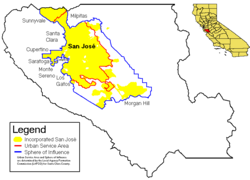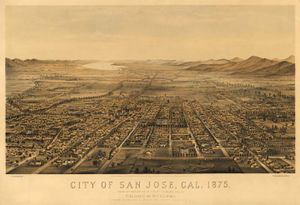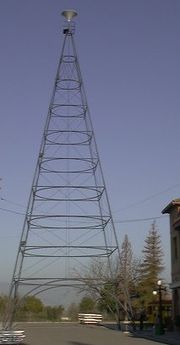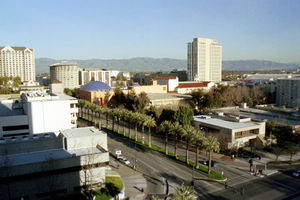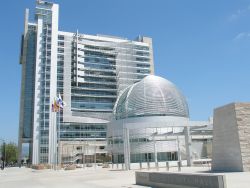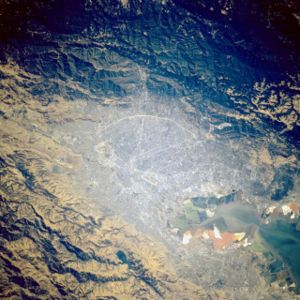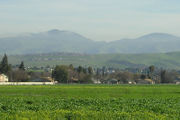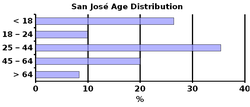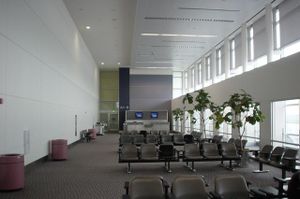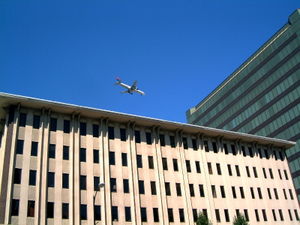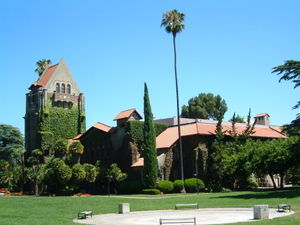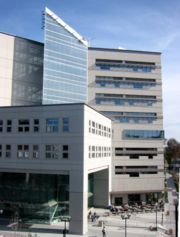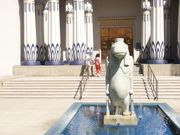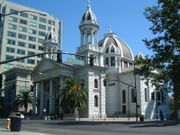San Jose, California
2007 Schools Wikipedia Selection. Related subjects: North American Geography
| San José, California | |||||
|
|||||
| Nickname: "Capital of Silicon Valley" | |||||
| Location of San Jose within Santa Clara County, California. | |||||
| Coordinates: | |||||
|---|---|---|---|---|---|
| Country | United States of America | ||||
| State | California | ||||
| County | Santa Clara | ||||
| Incorporated | March 27, 1850 | ||||
| Mayor | Ron Gonzales | ||||
| Vice Mayor | Cindy Chavez | ||||
| City Manager | Les White | ||||
| Area | |||||
| - City | 461.5 km² (178.2 sq mi) | ||||
| - Land | 452.9 km² (174.9 sq mi) | ||||
| - Water | 8.6 km² (3.3 sq mi) | ||||
| - Urban | 673.68 km² (260.11 sq mi) | ||||
| - Metro | 6,979.4 km² (2,694.7 sq mi) | ||||
| Elevation | 26 m (85 ft) | ||||
| Population | |||||
| - City (2006) | 953,679 (city proper) | ||||
| - Density | 1,976.1/km² (5,118.1/sq mi) | ||||
| - Urban | 1,611,000 | ||||
| - Metro | 1,741,431 | ||||
| Time zone | PST ( UTC-8) | ||||
| - Summer ( DST) | PDT ( UTC-7) | ||||
| Website: www.sanjoseca.gov | |||||
San José ( IPA: [sæn hoʊˈzeɪ]) is the third-largest city in California, and the tenth-largest in the United States. It is the county seat of Santa Clara County. For the past several years, it has held the title of The Safest Big City in America. San Jose is located in Silicon Valley, at the south end of the San Francisco Bay. With a population of 953,679, San Jose is the largest city in Northern California.
San Jose was founded in 1777 as the first town in the Spanish colony of Nueva California, which later became Alta California. The city served as a farming community to support Spanish military installations at San Francisco and Monterey. After California gained statehood in 1850, San Jose served as its first capital. After over 150 years as an agricultural centre, increased demand for housing from soldiers and other veterans returning from World War II and starting families, as well as aggressive expansion during the 1950s and 1960s led to San Jose being a bedroom community for Silicon Valley in the 1970s, which attracted more businesses to the city. By the 1990s, San Jose's central location within the booming technology industry in the area earned the city the nickname as the Capital of Silicon Valley.
On April 3, 1979, the city council adopted San José as the spelling of the city name on the city seal and official stationery; however, the name is still more commonly spelled without the diacritical mark. The official name of the city is The City of San José.
History
Site chosen by De Anza
For thousands of years before the arrival of European settlers, the area now known as San Jose was inhabited by several groups of Ohlone Native Americans. Permanent European presence in the area came with the 1770 founding of the Presidio of Monterey and Mission San Carlos Borromeo de Carmelo by Gaspar de Portolà and Father Junípero Serra, about sixty miles (100 km) to the south. Don Pedro Fages, the military governor at Monterey, passed through the area on his 1770 and 1772 expeditions to explore the East Bay and Sacramento River Delta. Late in 1775, Juan Bautista de Anza led an expedition to bring colonists from New Spain to California and to locate sites for two missions, one presidio, and one pueblo (town). He left the colonists at Monterey in 1776, and explored north with a small group. He selected the sites of the Presidio of San Francisco and Mission San Francisco de Asís in what is now San Francisco; on his way back to Monterey, he sited Mission Santa Clara de Asís and the pueblo San Jose in the Santa Clara Valley. De Anza returned to Mexico City before any of the settlements were actually founded, but his name lives on in many buildings and street names.
Early Spanish pueblo
El Pueblo de San José de Guadalupe (The Town of Saint Joseph from Guadalupe) was founded by José Joaquin Moraga on November 29, 1777, the first settlement not associated with a mission or a military post (presidio) in Alta California. (Mission Santa Clara, the closest mission, was founded earlier in 1777, three miles (5 km) from the original pueblo site in neighboring Santa Clara. Mission San José was not founded until 1797, about 20 miles (30 km) north of San Jose in what is now Fremont.) The town was founded by the colonists led to California by de Anza, as a farming community to provide food for the presidios of San Francisco and Monterey. In 1778, the pueblo had a population of 68. In 1797, the pueblo was moved from its original location, near the present-day intersection of Guadalupe Parkway and Taylor Street, to a location in what is now Downtown San Jose, surrounding Pueblo Plaza (now Plaza de César Chávez).
Early statehood
During the Bear Flag Revolt, Captain Thomas Fallon led a small force from Santa Cruz and captured the pueblo without bloodshed on July 11, 1846. Fallon received an American flag from John D. Sloat, and raised it over the pueblo on July 14, as the California Republic agreed to join the United States following the start of the Mexican-American War. Fallon would later become the tenth mayor of San Jose.
During the California Gold Rush period, the New Almaden Mines just south of the city were the largest mercury mines in North America (mercury was used to help separate gold from ore). The cinnabar deposits were discovered in 1845 by a Mexican cavalry captain, Don Andres Castillero, when he recognized the red powder used by local Ohlone Indians to decorate the chapel at Mission Santa Clara. Mining operations began in 1847 at what was the first operating mine in the province, just in time for the Gold Rush. The importance of the mercury industry at the time explains why the local newspaper is named the Mercury News.
On March 27, 1850, San Jose became the first incorporated city in the U.S. state of California; the first mayor was Josiah Belden. It also served as the state's first capital with the first and second sessions of the California Legislature, known as the Legislature of a Thousand Drinks, being held there in 1850 and 1851. The legislature was unhappy with the location, as no buildings suitable for a state government were available in the city, and took up State Senator Mariano Guadalupe Vallejo's offer to build a new capital on land he donated to the state in what is now Benicia.
In 1884, Sarah L. Winchester (née Pardee), the widow of William Winchester and heiress to the empire that manufactured the Winchester rifle, was told that the Winchester family was cursed and haunted by ghosts who were killed by the rifle. She moved from Connecticut to San Jose and began a construction project of such magnitude that it was to occupy the lives of carpenters and craftsmen until her death: the house was continually under construction for thirty-eight years. It is believed that she built the massive, bewildering house to confuse these spirits. Before the 1906 San Francisco Earthquake, the Winchester Mystery House reached a height of 7 stories; today it stands three stories with approximately 160 rooms. Many visitors to the house claim to have felt the presence of ghosts.
Notable events
In 1881, because of a forceful campaign by editor J.J. Owen of the San Jose Mercury, the city council authorized the construction of the San Jose Electric Light Tower, ostensibly to replace the gas streetlights that had illuminated downtown San Jose since 1861. It didn't provide sufficient illumination, and by 1884 was used only for ceremonial purposes. It collapsed during a gale in 1915. In 1989, an informal "Court of Historical Inquiry" looked into the issue of whether the Eiffel Tower was a copyright infringement of the Electric Light Tower; the Justice ruled that it was not.
The 1933 kidnapping and murder of Brooke Hart resulted in mob violence in San Jose. About 10,000 residents (approximately 1/6 of the city's population at the time) stormed the jail and lynched the two men who had confessed to the killing. The case drew international attention to San Jose, for the kidnapping, lynching, and for the praise that Governor James Rolph directed to those who participated. It is also notable as the last public lynching in California's history. Photos of the lynchings were even used as Nazi propaganda, to demonstrate that Americans were supportive of their Jewish population (the Hart family was Jewish).
Earthquakes
San Jose lies near the San Andreas Fault; a major source of earthquake activity in California. Significant quakes rocked the city in 1839, 1851, 1858, 1864, 1865, 1868,1891 and 1906. The Daly City Earthquake of 1957 caused some damage. Most recently, the Loma Prieta earthquake of 1989 also caused some major damage to parts of the city. The most serious earthquake, the 1906 San Francisco earthquake, with its epicenter slightly off the coast of San Francisco near Golden Gate Park , devastated many buildings in San Jose. The city was still primarily rural and the population much smaller than San Francisco, so houses and businesses were not so closely built, providing no opportunity for a major fire like the one that destroyed the city up the Peninsula. The all-brick Agnews Asylum (later Agnews State Hospital) suffered possibly the worst damage in the San Jose area, killing over 100 people as the walls and roof collapsed. The 8-year-old San Jose High School's three-story stone and brick structure also collapsed, and many other buildings were severely damaged. There have been many other earthquakes felt in San Jose that cause little or no damage other than causing a "stir" around town and a few broken bottles or windows. Although most damages from earthquakes are quickly repaired, if you look closely, earthquake damage may be seen around town in the way of cracked sidewalks, raised curbs, slanted or cracked walls, patched freeway divider walls. The other faults near San Jose are the Monte Vista Fault, South Hayward Fault, Northern Calaveras Fault, and Central Calaveras Fault.
Transition from agriculture to technology
For nearly two centuries a farming community, San Jose produced a significant amount of fruits and vegetables until the 1960s, and many past and current names of teams, streets, buildings, and so on reflect its agricultural beginnings. Prunes, grapes, and apricots were some of the major crops. In 1922, the first commercial farming of broccoli in the U.S. was started in San Jose, by brothers Stephano and Andrea D'Arrigo. The Del Monte cannery in Midtown was the largest employer in the city for many years.
Food Machinery Corporation (FMC) was founded in San Jose as the Bean Spray Pump Company in 1883. In 1941 the company received an order from the United States War Department for one thousand LVTs, bringing defense contracts to San Jose for the first time. After World War II, FMC continued as a defense contractor, with the San Jose facilities designing and manufacturing military platforms such as the M113 Armored Personnel Carrier, the Bradley Fighting Vehicle, and various subsystems of the M1 Abrams. FMC's military business would later be spun off into United Defense.
IBM established their west coast headquarters in San Jose in 1943. In 1952 they opened a research and development facility in downtown, where Reynold Johnson and his team invented RAMAC. In 1956 IBM opened its Cottle Road manufacturing facility in the Santa Teresa neighbourhood, where disc drives were invented in 1962. IBM moved the research and development operation out of downtown, opening the Santa Teresa Laboratories in the Coyote Valley in 1976, and the Almaden Research Centre in 1986.
Growth
A. P. Hamann (nicknamed "Dutch") became city manager in 1950. At the time, the city had a population of 95,280 and a total area of only 17 square miles. Hamann instituted an aggressive growth program by annexation of adjacent areas, such as Alviso and Cambrian Park, and a program of dispersed urbanization, called urban sprawl. Hamann also spent significant time on the East Coast, selling San Jose as an ideal place for businesses to expand into. Hamann's efforts resulted in an annual population growth rate of over eight percent. When Hamann left office in 1969, San Jose had grown to 495,000 residents and 136 square miles.
The costs of uncontrolled growth—high municipal debt load, deteriorating public services (including double sessions at public schools overtaxed fire and police services), and environmental degradation—triggered a populist revolt against Hamann's growth machine. In the late 1960s, several anti-growth candidates were elected to the City Council. Seeing the writing on the wall, Hamann retired. In 1971, Norman Mineta--who had been appointed to fill a vacant City Council seat by pro-growth Mayor Ron James but who proved to be an independent—was elected Mayor. During the early 1970s, a feminist-environmentalist electoral alliance consolidated a liberal, anti-growth majority on the City Council. In a final coup against the growth machine, voters elected Janet Gray Hayes as mayor in 1974. Since then, San Jose has been governed by a liberal-managerial regime focused on growth management, neighbourhood services, and fiscal solvency.
Subsequently, the city adopted a general plan that established an "urban service area" (also known as "urban growth boundary") within existing city boundaries, limited development in the eastern foohills, and deferred growth in Coyote Valley to the south. To the west, communities such as Campbell and Cupertino had incorporated as cities to avoid being annexed to San Jose, while expansion to the north was impossible because of San Francisco Bay. The city also adopted more rigorous planning practices and a "pay-as-you-grow" system of paying for new infrastructure. However, San Jose's new policies did not stop or even significantly restrict growth; rather, they directed growth towards incorporated areas and mitigated the costs of growth. The city's housing stock and population steadily increased during subsequent decades.
Indeed, continued growth has created enormous challenges for the city and region. With the boom of the electronics industry, specifically personal computers and integrated circuits, the population of San Jose and Silicon Valley continued to grow rapidly. By 1980, the city's population was 629,442; it reached 782,248 by 1990; and at which point Santa Clara County as a whole had grown to 1,682,585 residents. Because of rapid job growth and in-migration, housing costs in San Jose and the rest of the Bay Area rose faster than the national average in the 1980s and 1990s; between 1976 and 2001, San Jose's housing costs increased by 936%, the fastest growth in the nation over that time. The average 2003 home price in Santa Clara County was approximately 330% of the national average.
In response, the city has tried to direct growth inward and densify already urbanized areas. In 1994, the city council approved another general plan with the original 1974 urban growth boundaries intact. In 1998, city voters rejected a ballot measure that would have eased development restrictions in the foothills. Sixty percent of the housing built in San Jose since 1980 and over three-quarters of the housing built since 2000 have been multifamily structures, reflecting an orientation towards Smart Growth planning principles.
Many people's view of San Jose is still formed by the Dionne Warwick hit from 1968, "Do You Know the Way to San Jose?" Written by Burt Bacharach and Hal David (neither of whom had spent time there and chose the name because it suited the tune), it includes the lyrics, "there's a lot of space in San Jose; there'll be a place where I can stay" and "I may go wrong and lose my way," and contrasts it to Los Angeles, "a great big freeway." In 1960, the population of San Jose was only 204,000, just over a fifth of the 2003 population. The only freeway through or near San Jose was U.S. Route 101, which touched only the outermost edges of the city and was still a rural route or controlled by traffic lights in some areas. A large portion of the Santa Clara Valley still contained commercial orchards.
Law and government
San Jose is a charter city under California law, giving it the power to enact local ordinances that may conflict with state law, within the limits provided by the charter. The city has a council-manager government with a city manager nominated by the mayor and elected by the city council.
The San José City Council is made up of ten council members elected by districts, and a mayor elected in an at-large election. During city council meetings, the mayor presides, and all eleven members can vote on any issue. The mayor has no veto powers. Council members and the mayor are elected to four-year terms; the even-numbered district council members beginning in 1994; the mayor and the odd-numbered district council members beginning in 1996. Council members and the mayor are limited to two successive terms in office, although a council member that has reached the term limit can be elected mayor, and vice versa. The council elects a vice-mayor from the members of the council at the second meeting of the year following a council election. This council member has the right to act as mayor during the temporary absence of the mayor, but does not have the right of succession to the mayor's office upon a vacancy.
The City Manager is the chief administrative officer of the city, and must present an annual budget for approval by the city council. The council elects the manager for an indefinite term, and may at any time remove the manager, or the electorate may remove the manager through a recall election. Other city officers elected by the council are the city attorney, city auditor, and city clerk.
Like all California cities except San Francisco, both the levels and the boundaries of what the city government controls is determined by the local county (LAFCO). The goal of a LAFCO is to try to avoid uncontrolled urban sprawl. The Santa Clara County LAFCO has set boundaries of San Jose's 'Sphere of Influence' (indicated by the blue line in the map near the top of the page) as a superset of the actual city limits (the yellow area in the map), plus parts of the surrounding unincorporated county land, where San Jose can, for example, prevent development of fringe areas to concentrate city growth closer to the city's core. The LAFCO also defines a subset of the Sphere as an 'Urban Service Area' (indicated by the red line in the map), effectively limiting development to areas where urban infrastructure (sewers, electrical service, etc.) already exists.
San Jose has consistently been ranked as one of the safest large cities in the United States. During the 1990s and 2000s, the crime rate has consistently fallen. From 2001 to 2005 the city was ranked as the safest American city with a population over 500,000 by the Morgan Quitno Awards. The designation is based on crime statistics reported to the Federal Bureau of Investigation in six categories: murder, rape, robbery, aggravated assault, burglary, and auto theft. However, reports of police brutality have become more common.
Sister/twin cities
The Office of Economic Development coordinates the San Jose Sister City Program. As of 2006, there are seven sister cities (aka twinned towns):
 - Okayama, Japan (established in 1957)
- Okayama, Japan (established in 1957) - San José, Costa Rica (1961)
- San José, Costa Rica (1961) - Veracruz, Mexico (1975)
- Veracruz, Mexico (1975) - Tainan, Taiwan (1975)
- Tainan, Taiwan (1975) - Dublin, Republic of Ireland (1986)
- Dublin, Republic of Ireland (1986) - Pune, India (1992)
- Pune, India (1992) - Ekaterinburg, Russia (1992)
- Ekaterinburg, Russia (1992)
Geography
San Jose is located at (37.304051, −121.872734) ¹.
According to the United States Census Bureau, the city has a total area of 461.5 km² (178.2 mi²) GR1. 452.9 km² (174.9 mi²) of it is land and 8.6 km² (3.3 mi²) of it (1.86%) is water.
San Jose lies near the San Andreas Fault; a major source of earthquake activity in California. The most serious earthquake, in 1906, damaged many buildings in San Jose as described earlier. Earlier significant quakes rocked the city in 1839, 1851, 1858, 1864, 1865, 1868, and 1891. The Daly City Earthquake of 1957 caused some damage. The Loma Prieta earthquake of 1989 also did some damage to parts of the city. The other faults near San Jose are the Monte Vista Fault, South Hayward Fault, Northern Calaveras Fault, and Central Calaveras Fault.
The Guadalupe River runs from the Santa Cruz Mountains (which separate the South Bay from the Pacific Coast) flowing north through San Jose, ending in the San Francisco Bay at Alviso. Along the southern part of the river is the neighbourhood of Almaden Valley, originally named for the mercury mines which produced mercury needed for gold extraction from quartz during the California gold rush as well as mercury fulminate blasting caps and detonators for the U.S. military from 1870 to 1945.
The lowest point in San Jose is at sea level at the San Francisco Bay in Alviso; the highest is 4,372 feet (1,333 m) at Copernicus Peak, Mount Hamilton, which is technically outside the city limit. Due to the proximity to Lick Observatory atop Mount Hamilton, San Jose has taken several steps to reduce light pollution, including replacing all street lamps with low pressure sodium lamps. To recognize the city's efforts, the asteroid 6216 San Jose was named after the city. Some residents object to the deep yellow colour of the streetlights, saying they are distracting because they are the same shade of yellow as traffic lights and other illuminated traffic warnings.
Climate
San Jose, like most of the Bay Area, has a Mediterranean climate tempered by the presence of the San Francisco Bay. Unlike San Francisco, which is exposed to the ocean or Bay on three sides and whose temperature therefore varies relatively little year-round and overnight, San Jose lies more inland, protected on three sides by mountains. This shelters the city from rain and makes it more of a semiarid, near-desert area, with a mean annual rainfall of only 14.4 inches (366 mm), compared to some other parts of the Bay Area, which can get up to four times that amount. It also avoids San Francisco's omnipresent fog most of the year.
However, temperatures are generally moderate. January's average high is 59 °F (15 °C) and average low is 42 °F (6 °C), with overnight freezes several nights each year; July's average high is 84 °F (29 °C) and average low is 58 °F (14 °C), with heat exceeding 100 °F (38 °C) several days each year. The highest temperature ever recorded in San Jose was 109 °F (42.8 °C) on June 14, 2000; the lowest was 17 °F (-8.3 °C) on January 9, 1920 and January 10, 1920. Temperatures between night and day can vary by 30 or 40 °F (17 to 22 °C).
With the light rainfall, San Jose experiences over 300 days a year of full or significant sunshine. Rain occurs primarily in the months from October through April or May, with hardly any rainfall from June through September. During the winter, hillsides and fields turn green with native grasses and vegetation, although deciduous trees are bare; with the coming of the annual summer dry period, the vegetation dies and dries, giving the hills a golden cover, which some find beautiful but which also provides fuel for frequent grass fires.
The snow level drops as low as 2,000 ft (610 m) above sea level, or lower, occasionally each winter, coating nearby Mount Hamilton, and less frequently the Santa Cruz Mountains, with snow that normally lasts a few days. This sometimes snarls traffic traveling on State Route 17 towards Santa Cruz. Snow occasionally falls in San Jose, but until recently, the most recent snow to remain on the ground was in February of 1976 when many residents around the city saw as much as 3 inches on car and roof tops. However, in March of 2006, a smaller amount, up to one inch of snow fell in downtown San Jose as well as other areas around the city at elevations of only 90 feet to 200 feet above sea level.
Again, like most of the Bay Area, San Jose is made up of dozens of microclimates. Downtown San Jose experiences the lightest rainfall in the city, while South San Jose, only 10 miles (16 km) distant, experiences more rainfall and slightly more extreme temperatures.
Economy
San Jose considers itself "the Capital of Silicon Valley." As such, its economy rises and falls with high-tech employment in the Bay Area. During the peak of the tech bubble, employment, housing prices, and traffic congestion peaked, but all eased as the economy slowed during the first few years of the 21st century. As of 2006, the city reported 405,000 jobs within the city limits and an unemployment rate of 4.6%. San Jose had the highest median household income of any city with a population over 300,000 in 2000, and currently has the highest median income of any city with over 225,000 people.
The city lists 25 companies with 1,000 employees or more, including the headquarters of Adobe Systems, BEA Systems, Cisco, and eBay, as well as major facilities for Flextronics, Hewlett-Packard, IBM, Hitachi and Lockheed Martin. Sizable government employers include the city, Santa Clara County, and San José State University.
The cost of living in San Jose and the surrounding areas is among the highest in California and the nation. Housing costs in the city are the primary reason for the high cost of living, although the costs in all areas tracked by ACCRA are above the national average. Despite the high cost of living, San Jose households have the highest disposable income of any large American city. San Jose residents produce more U.S. patents than any other city, the average worker productivity in San Jose is double the national average, and 35% of venture capital funds in the U.S. are invested in San Jose and Silicon Valley companies.
Demographics
As of the census GR2 of 2000, there were 894,943 people (although CA State figures currently put that number closer to 950,000), 276,598 households, and 203,576 families residing in the city. The population density was 1,976.1/km² (5,117.9/mi²). There were 281,841 housing units at an average density of 622.3/km² (1,611.8/mi²). The racial makeup of the city was 47.49% White, 3.50% African American, 0.77% Native American, 26.86% Asian, 0.40% Pacific Islander, 15.94% from other races, and 5.04% from two or more races. Hispanic or Latino of any race were 30.17% of the population.
There were 276,598 households out of which 38.3% had children under the age of 18 living with them, 56.0% were married couples living together, 11.7% had a female householder with no husband present, and 26.4% were non-families. 18.4% of all households were made up of individuals and 4.9% had someone living alone who was 65 years of age or older. The average household size was 3.20 and the average family size was 3.62.
In the city the population was spread out with 26.4% under the age of 18, 9.9% from 18 to 24, 35.4% from 25 to 44, 20.0% from 45 to 64, and 8.3% who were 65 years of age or older. The median age was 33 years. For every 100 females there were 103.3 males. For every 100 females age 18 and over, there were 102.5 males.
The median income for a household in the city was the highest in the US for any city with more than a quater million residents with $70,243 annually. The median income for a family was $74,813. Males had a median income of $49,347 versus $36,936 for females. The per capita income for the city was $26,697. About 6.0% of families and 8.8% of the population were below the poverty line, including 10.3% of those under age 18 and 7.4% of those age 65 or over.
The San Francisco Bay Area has a very diverse religious life with thousands of churches, mosques, temples, and religious centers. The Bay Area is home to Buddhist, Sikh, Christian, Jewish, Hindu, Shiite-Muslim, Sunni-Muslim, Jehovah's Witnesses, and numerous other religious communities.
Arts and architecture
San Jose's downtown architecture is noted more for its limited height than for any particular buildings. Because the downtown area is in the flight path to nearby Mineta San Jose International Airport, there is a permanent height limit for all buildings. There has been broad criticism, both in the past and present, of the city's architecture. It has been said that San Jose's buildings are, in fact, rather lacking in ornamentation, or aesthetically pleasing architectural style. The thorough re-development of the downtown area in the 1960s to the present, in which whole blocks of buildings were razed, has often been blamed for this.
Municipal building projects have experimented more with architectural styles than have most private enterprises. The Children's Discovery Museum, Tech Museum of Innovation, and the San Jose Repertory Theatre building have experimented with bold colors and unusual exteriors. The new City Hall, designed by Richard Meier & Partners opened in 2005 and is a notable addition to the growing collection of municipal building projects.
Public art is an evolving attraction in the city. The City was one of the first to adopt a public art ordinance at 2% of capital improvement building project budgets, and the results of this commitment are beginning to have an impact on the visual landscape of the City. There is a considerable amount throughout the downtown area, and a growing collection in the City's neighbourhood newer civic locations including libraries, parks, and fire stations. Of particular note, the Mineta Airport expansion will incorporate a program of Art & Technology into its development.
Within the early efforts at public art, there are notable controversies. Two examples, include the statue of Quetzalcoatl (the plumed serpent) in downtown which was controversial in its planning because some religious groups felt that it was pagan, and controversial in its implementation because many felt that the final statue by Robert Graham did not closely resemble a winged serpent, and was more noted for its expense than its aesthetics. Locals have been known to jokingly call the statue the "Park God," referring to its shape. The statue of Thomas Fallon also met strong resistance from those who felt that people like him were largely responsible for the decimation of early native populations.
In 2001, the city sponsored SharkByte, an exhibit of decorated sharks, based on the mascot of the hockey team, the San Jose Sharks, and modeled after Chicago's display of decorated cows. Large models of sharks were decorated in a variety of clever, colorful, or creative ways by local artists and were then displayed for months at dozens of locations around the city. Many displays were removed early because of vandalism. After the exhibition, the sharks were auctioned off and the proceeds donated to charity. The sharks can still be found in their new owners' homes and businesses.
The city is home to many performance arts, including Opera San Jose, Symphony Silicon Valley, Ballet San Jose Silicon Valley, the San Jose Repertory Theatre, and American Musical Theatre of San Jose. San Jose also is home to the San Jose Museum of Art, one of the nation's premiere Modern Art museums. In addition, the annual Cinequest Film Festival in downtown has grown to over 60,000 attendees per year, becoming an important festival for independent films.
The HP Pavilion is one of the most active venues for events in the world. According to Billboard Magazine and Pollstar, the arena sold the most tickets to non-sporting events of any venue in the United States, and third in the world after the Manchester Evening News Arena in Manchester, England, and the Bell Centre in Montreal, Quebec, Canada, for the period from January 1 – September 30, 2004. Including sporting events, the HP Pavilion averages 184 events a year, or roughly one event for every two days, which is significantly higher than the average for NHL arenas.
Sports
| Club | Sport | Founded | League | Venue |
|---|---|---|---|---|
| San Jose Sharks | Hockey | 1991 | National Hockey League: Western Conference | HP Pavilion |
| San Jose SaberCats | Arena Football | 1995 | Arena Football League | HP Pavilion |
| San Jose Stealth | Lacrosse | 2003 | National Lacrosse League | HP Pavilion |
| San Jose Giants | Baseball | 1988 | California League | San Jose Municipal Stadium |
San Jose is also home to the St Joseph's Hurling Club.
Previously, San Jose was home to the San Jose Earthquakes of the North American Soccer League (1974-1984), Western Soccer Alliance (1985-1988), and Major League Soccer (1996-2005), the San Jose Grizzlies (1993-1995) of the Continental Indoor Soccer League, the San Jose Golddiggers (1987-1989) of Major League Volleyball (women's), the San Jose Jammers (1989-1991) of the Continental Basketball Association, the San Jose Lasers of the American Basketball League, the Golden State Warriors of the National Basketball Association (while Oakland Arena was being renovated, 1996-1997), the San Jose CyberRays of the Women's United Soccer Association (2001-2002), and the San Jose Ballers of the International Basketball League (2005-), now the Tri City Ballers.
In addition to professional teams, San Jose hosts several sporting events. The SAP Open (formerly the Sybase Open) is an annual men's tennis tournament held at the HP Pavilion. San Jose was the host of ArenaBowl XVI on August 18, 2002 in which the San Jose SaberCats defeated the Arizona Rattlers, 52-14. The San Jose Grand Prix, first held in July 2005, brings Champ Car racing on a temporary road course on Downtown streets. The city is also one of five host cities for the inaugural Dew Action Sports Tour season; the San Jose event was held in September 2005.
In college sports, the San José State Spartans are the local college team, however, many residents support the Cal Golden Bears or the Stanford Cardinal; local sports news coverage tends to focus more on these two schools. The Pac-10 Women's Basketball Championship is held at the HP Pavilion as well as either the men's or women's West Regional tournament during the NCAA's March Madness.
In 2004, the San Jose Sports Authority hosted the U.S. Olympic team trials for judo, taekwondo, trampolining and rhythmic gymnastics at the San Jose State Event Centre. In August 2004, the Authority hosted the USA All-Star 7-Aside Rugby Championships at Watson Bowl, east of Downtown.
Transportation
The San Jose area has a well-developed freeway system, including three Interstate highways— I-280, I-880, and I-680—in addition to several federal and state highways, US 101, CA-85, CA-87, CA-17, and CA-237. It is, however, the largest city in the country not served by a primary, "two-digit" interstate. Additionally, San Jose contains many expressways of the Santa Clara County Expressway System, including the Almaden Expressway, Capitol Expressway, San Tomas Expressway, and Lawrence Expressway.
Rail service to and within San Jose is provided by Amtrak (the Sacramento-San Jose Capitol Corridor and the Seattle-Los Angeles Coast Starlight), Caltrain (commuter rail service between San Francisco and Gilroy), ACE (commuter rail service to Pleasanton and Stockton), and a local light-rail system connecting downtown to Mountain View, Milpitas, Campbell, and Almaden Valley, operated by the Santa Clara Valley Transportation Authority (VTA). Historic streetcars from the San Jose History Museum operate on the light rail lines in downtown during holidays. Long-term plans call for BART to be expanded into the San Jose area via the East Bay. Diridon Station (formerly Cahill Depot, 65 Cahill Street) is the meeting point of all regional commuter rail service in the area. It was built in 1935 by the Southern Pacific Railroad, and was refurnished in 1994.
VTA also operates many bus routes in San Jose and the surrounding communities, as well as offering paratransit services to local residents. Additionally, the Highway 17 Express bus line connects central San Jose with Santa Cruz.
San Jose is served by Mineta San Jose International Airport, two miles (3 km) northwest of downtown, and by San Jose/Reid-Hillview Airport of Santa Clara County. San Jose residents also use San Francisco International Airport, a major international hub located 35 miles (56 km) to the northwest, and Oakland International Airport, another medium-sized airport located 35 miles (56 km) to the north. Some large airlines that fly into San Jose are American Airlines, Southwest Airlines, United Airlines, Jet Blue Airways, Northwest Airlines, America West Airlines, Alaska Airlines, Continental Airlines, Delta Air Lines, Frontier Airlines, Hawaiian Airlines, and Mexicana Airlines.
Utilities
Potable water is provided primarily by the private-sector San Jose Water Company, with some by the Great Oaks Water Company, and ten percent by the public-sector San Jose Municipal Water System. Great Oaks provides exclusively well water, while the other two provide water from multiple sources, including well water, and surface water from the Los Gatos Creek watershed, Santa Clara Valley Water District, and the San Francisco Public Utilities Commission's Hetch Hetchy reservoir.
Garbage, wastewater treatment, and recycling services are overseen by the city of San Jose's Environmental Services Department. The no-sorting convenience and unusually long list of recyclable items has resulted in San Jose being one of very few cities that can boast that it recycles 64% of its waste. The list includes all plastic categories 1 through 7; aerosol cans and paint cans; polystyrene including " packing peanuts" and hard foam packing, such as in electronic and computer products' boxes; aluminium furniture; small metal appliances; metal pots and pans (including cast iron); and clean cotton, linen, polyester, rayon, and wool fabrics (for example, blankets, clothes, cloth diapers, rags, and sheets).
Wastewater treatment happens at the San Jose/Santa Clara Water Pollution Control Plant, which treats and cleans the wastewater of the more than 1,500,000 people that live and work in the 300 square mile (780 km²) area encompassing San Jose, Santa Clara, Milpitas, Campbell, Cupertino, Los Gatos, Saratoga, and Monte Sereno.
About ten percent of the treated wastewater is sold for irrigation ("water recycling") in San Jose, Santa Clara, and Milpitas, through local water providers San Jose Municipal Water System, City of Milpitas Municipal Services, City of Santa Clara Water & Sewer Utility, Santa Clara Valley Water District, San Jose Water Company, and Great Oaks Water Company.
Natural gas and electricity are provided by PG&E. Telephone service is provided primarily by AT&T. Cable television is provided by Comcast.
Education
Colleges and universities
San Jose is home to several colleges and universities. The largest and most well known is San José State University, which was founded by the California Legislature in 1862 as the California State Normal School and is the original campus of the California State University system. Located in downtown San Jose since 1870, the university's 30,000 students in bachelor's and master's degree programs are primarily commuters from many areas in the South Bay. National Hispanic University, with an enrollment of 600, offers associate and bachelor's degrees and teaching credentials to its students, focusing on Hispanic students. Silicon Valley College offers bachelor's and associate degrees useful for workers in high technology industries. Lincoln Law School of San Jose offers law degrees, catering to working professionals. The San Jose campus of Golden Gate University offers business bachelor and MBA degrees. San Jose's community colleges, San Jose City College and Evergreen Valley College, offer associate degrees, general education units to transfer to CSU and UC schools, and adult and continuing education programs.
The University of California, Santa Cruz operates Lick Observatory atop Mount Hamilton. In addition, San Jose residents attend several other area universities, including Santa Clara University, De Anza College in Cupertino, Stanford University in Palo Alto, Carnegie Mellon West in Mountain View and the University of California, Berkeley.
Primary and secondary education
Most San Jose students go to schools in the San Jose Unified School District. Prior to 1954, California law required cities and school districts to have the same boundaries. When San Jose began expanding, rural school districts became one of the major opponents, as their territory and tax base was taken by the city. The city's legislators pushed a bill through the California Legislature, removing that requirement, and ending much of the opposition. The result is a patchwork of local school districts in the areas annexed after 1954. Public education in the city is provided by four high school districts, fourteen elementary districts, and four unified school districts (which provide both elementary and high schools).
In addition to the main San Jose Unified School District, the unified school districts are Milpitas Unified School District, Morgan Hill Unified School District, and Santa Clara Unified School District.
The following districts use the "feeder" system:
- Campbell Union High School District receives students from:
- Cambrian
- Campbell Union
- Luther Burbank
- Moreland
- Union School District.
- East Side Union High School District receives students from:
- Alum Rock Union
- Berryessa Union
- Evergreen Elementary
- Franklin-McKinley
- Mount Pleasant Elementary
- Oak Grove
- Orchard Elementary
- Fremont Union High School District receives students from:
- Cupertino Union School District.
- Los Gatos-Saratoga Joint Union High School District receives students from
- Los Gatos Union School District.
Private schools in San Jose are primarily run by religious groups. The Catholic Diocese of San Jose has the second largest student population in the Santa Clara County, behind only SJUSD; the diocese and its parishes operate several schools in the city, including four high schools: Archbishop Mitty High School, Bellarmine College Preparatory, Notre Dame High School, and Presentation High School . There are two Baptist high schools, Liberty Baptist School and White Road Baptist Academy. Valley Christian High School is a Protestant high school in the North Valley neighbourhood. There is also the nonsectarian K-12 Harker School.
San Jose library system
The San Jose City Library system is unique in that the Dr. Martin Luther King, Jr. Library combines the collections of the city's system with the San Jose State main library. The library is the largest (built all at once) west of the Mississippi River, with a 1.5 million item collection.
The city has 20 neighbourhood branches including the Biblioteca Latinoamericana which specializes in Spanish language works. The East San Jose Carnegie Branch Library, a Carnegie library opened in 1908, is the last Carnegie library in Santa Clara County still operating as a public library and is listed in the National Register of Historic Places. The Calabazas Branch has four primary language-specific collections: Chinese, Japanese, Korean, and Russian. Vineland Library was nominated library of the year 2004.
Neighborhoods
| Neighborhoods of San Jose, California | |
|---|---|
| Central | Downtown San Jose · Japantown · Rose Garden · Sunol-Midtown · Willow Glen · Naglee Park · Newhall/College Park |
| West | Burbank · Cambrian Park · West San Jose · Winchester |
| North | Alviso · Berryessa · North Valley |
| East | Alum Rock · East Foothills · King and Story · Little Portugal |
| South | Almaden Valley · Blossom Valley · Coyote Valley · Evergreen · Santa Teresa · San Felipe Valley · Silver Creek Valley |
| Nearby cities |
West: Cupertino · Mountain View · Santa Clara · Sunnyvale |
Attractions
Parks, gardens, and other outdoor recreational sites
- Almaden Quicksilver County Park, 4,147 acres (17 km²) of former mercury mines in South San Jose
- Alum Rock Park, 718 acres (2.9 km²) in East San Jose, the oldest municipal park in California
- Emma Prusch Farm Park, 43.5 acres (176,000 m²) in East San Jose. Donated by Emma Prusch to demonstrate the valley's agricultural past, it includes a 4-H barn (the largest in San Jose), community gardens, a rare-fruit orchard, demonstration gardens, picnic areas, and expanses of lawn.
- Kelley Park, including diverse facilities such as Happy Hollow Park & Zoo (a child-centric amusement park), the Japanese Friendship Garden, History Park at Kelley Park, and the Portuguese Historical Museum within the history park
- Kirk Park, home to the San Jose Young People's Theatre
- Overfelt Gardens, including the Chinese Cultural Garden
- Plaza de César Chávez, a small park in Downtown, hosts outdoor concerts and the Christmas in the Park display.
- Raging Waters, water park with water slides and other water attractions. This sits with in Lake Cunningham Park
- San Jose Municipal Rose Garden, 5½ acre (22,000 m²) park in the Rose Garden neighbourhood, featuring over 4,000 rose bushes
Museums, libraries, and other cultural collections
- Children's Discovery Museum of San Jose
- History Park at Kelley Park
- Ira F. Brilliant Centre for Beethoven Studies, home of the largest Beethoven collection outside Europe
- Dr. Martin Luther King, Jr. Library, the largest U.S. public library west of Mississippi River
- Mexican Heritage Plaza, a museum and cultural centre for Mexican Americans in the area
- Portuguese Historical Museum
- Rosicrucian Egyptian Museum, home of the largest collection of Egyptian relics in the western United States
- San Jose Museum of Art
- The Tech Museum of Innovation
Sports and event venues
- HP Pavilion - home of the NHL's San Jose Sharks and the AFL's San Jose SaberCats
- San Jose Convention Centre-home of the CBA's San Jose Sky Rockets.
- San Jose Municipal Stadium, home of the minor league San Jose Giants.
- Spartan Stadium, home of San José State University football and the former Major League Soccer's San Jose Earthquakes
- San Jose Grand Prix, Champcar racing on a temporary Downtown street course.
Restaurants and bars
There are many places to eat or enjoy Happy Hour in Downtown San Jose
Other structures
- Cathedral Basilica of St. Joseph, the oldest parish in California
- Lick Observatory, home of what was once the largest telescope in the world
- Sikh Gurdwara - San Jose, the largest Gurdwara (a Sikh temple) in the United States
- Peralta Adobe, a restored adobe home showing the lifestyle of Spanish and Mexican California
- Winchester Mystery House, a sprawling, 160-room Victorian mansion built by Sarah Winchester
- Raging Waters, the largest water park in Northern California with 23 acres and millions of gallons of water


